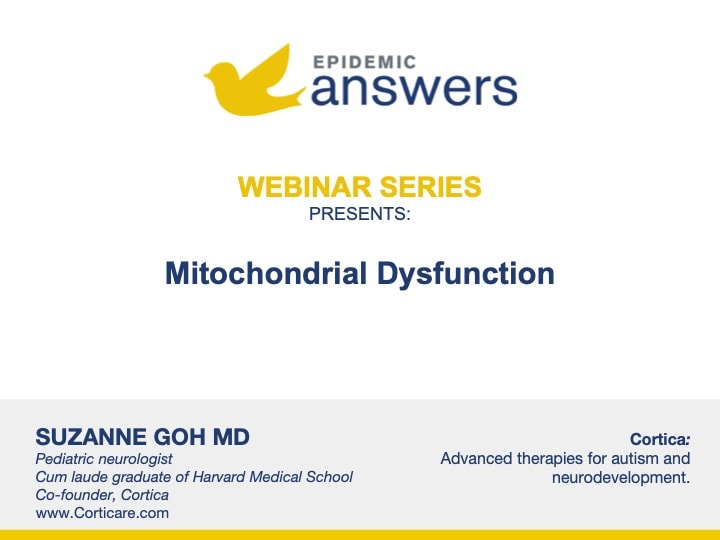In this blog post, nutritionist Kelly Dorfman explains how certain mitochondria-boosting supplements can help with hyptonia.
Many children with developmental delays have low muscle tone, or hypotonia, because external factors that impact the nervous system can also affect the muscles. Birth trauma, heavy antibiotic use, and exposure to toxins damage all types of cells, causing generalized low tone or low tone in specific areas such as the hands or mouth.
In severe cases of hypotonia, the muscles may be so weak that a child has difficulty sitting up for extended periods, chewing, or pushing out bowel movements. Milder cases, affecting the finger or eye muscles, cause fine motor delays or visual processing disorders. All children with hypotonia have reduced stamina.
Symptoms Associated with Hypotonia
- Fatigue/low arousal: The body’s inefficient processing of nutrients results in reduced available energy overall.
- Reflux/constipation: Poor or reduced trunk tone can cause stomach flaps to flop, thus impeding food movement.
- Poor sitting posture, “W” sitting or “slumping” can be a result of soft trunk muscles.
- Weak chewing and poor/picky eating: Low tone in the mouth affects mastication, causing drooling when saliva pools in the open mouth.
- Poor visual tracking: Weak eye muscles struggle to control and coordinate eye movements.
What You Eat Versus What You Get in Hypotonia
A big gap exists between what a child consumes and healthy cellular nutrition. While neurologists often attribute hypotonia to imbalances in the parts of the brain that control tone, low tone always has a nutritional component. Muscles suffering from nutrient deprivation remain underdeveloped, or if adequately developed, fatigue easily.
Whether a youngster is born with low tone, or acquires it through cellular malnutrition, good nutrition can improve the condition, while the tendency toward hypotonia often remains. Eating a high-nutrient diet is only the beginning in low tone. The nutrients must get to the cells, which must then convert them into usable energy.
Three basic strategies can improve inefficient energy delivery and boost output:
- Increasing available nutrients
- Enhancing nutrient delivery
- Improving energy production
All of these can be achieved with specific nutritional supplements. Nutritional therapy for low tone is a long-term management plan, not a quick fix.
Increasing Available Nutrients Through Diet
The first step is to control the intake of concentrated sugars, such as candies, sweetened drinks, and desserts, while increasing the amount of protein, fat and fiber in the diet. People with hypotonia tire easily so they often reach for sweets and starches as quick sources of energy and may often have hypoglycemia (low blood sugar). Foods with higher amounts of fat, fiber and protein tend to contain more concentrated nutrients than sugary items, which have many calories and few vitamins and minerals.
Improving nutrient density is critical because inefficient energy production result is loss of nutrients.
Enhancing Nutrient Delivery
Children with hypotonia often have underlying mitochondrial dysfunction, which is often addressed with a “mito cocktail” of supplements that can boost energy production. Here are some of the more common supplements. For more specific detail, please see our page on mitochondrial dysfunction.
Carnitine
Carnitine (as L-carnitine or acetyl-L-carnitine) carries partially digested fat molecules across the mitochondria membrane. The mitochondria convert fats and carbohydrates into adenosine triphosphate (ATP), the cells’ main source of energy. Carnitine is a simple protein made up of the amino acids methionine and lysine. Children with severe hypotonia often have low levels of carnitine in their blood.
Carnitine is usually dosed at 50 to 100 mg per kg of body weight. It improves tone in the intestines, making it wonderful for constipation. It can cause loose stools or stomach distress in some cases.
R-Alpha Lipoic Acid (R-ALA)
R-ALA is an antioxidant with both water- and fat-soluble properties. It lengthens the life-span of antioxidants like vitamins C, E, and glutathione, prolonging their usefulness in the body. Studies have found it allows the mitochondria to rebuild, thereby increasing ATP synthesis. The normal range of dosing is 25-100 mg of the “R” form.
Improving Energy Production
Co-enzyme Q-10 (CoQ10)
CoQ10 also called ubiquinone, helps to regenerate ATP. The body stores only enough ATP to provide energy for about five to eight seconds of strenuous activity, so it must constantly regenerate ATP using CoQ10. No CoQ10, no stamina. The beginning dose of CoQ10 is 30-60 mg and can go up to 100 mg. CoQ10 is non-toxic and well tolerated.
B Vitamins
These vitamins are required as cofactors at different points in energy production. Imagine energy production as an assembly line: The workers along the line are the B vitamins. Adding more B vitamins is like hiring more laborers in a slow factory. That’s why B vitamins have a reputation for improving energy.
Use B vitamins as a complex. Youngsters with low tone need a minimum of several times 100% of the daily value on vitamin bottles. While B vitamins are non-toxic, they can make some children cranky, possibly because yeasts like them, too. Keep in close contact with your supervising medical professional to adjust the B-vitamins if a child becomes agitated.
Vitamin E
This vitamin helps clean up oxidative damage from inefficient energy production. Free radicals are natural and destructive by-products of metabolism produced in much higher amounts when tone is poor.
The vitamin E family, four tocopherols and four tocotrienols, also protects the fats in cell membranes including the mitochondria membrane, against damage. Because nutritionists actively debate which member of this family has the highest antioxidant activity, it’s best to use the entire family.
About Kelly Dorfman MS LND
Kelly Dorfman is one of the world’s foremost experts on using nutrition therapeutically to improve brain function, energy and mood. Kelly’s special talent for integrating information from many sources and finding practical solutions has made her a popular speaker and workshop leader. She lectures extensively and is a member of Platform (formerly the National Speakers Association) and has been featured on numerous television programs including CNN’s American Morning.
Kelly’s award winning book, Cure Your Child With Food: The Hidden Connection Between Nutrition and Childhood Ailments (formerly known as What’s Eating Your Child) was given rave reviews by Publishers Weekly and the Washington Post.

As a go-to expert on nutrition issues, Kelly is frequently interviewed and quoted in the media. She has been featured in articles in The Wall Street Journal, Parade, Bethesda magazine, Living Without magazine, and the Huffington Post.
Kelly holds a master’s degree in nutrition/biology and is a licensed nutrition dietitian. She is a co-founder of Developmental Delay Resources, which has merged with Epidemic Answers. You can find out more about Kelly and her practice at kellydorfman.com
Still Looking for Answers?
Visit the Epidemic Answers Practitioner Directory to find a practitioner near you.
Join us inside our online membership community for parents, Healing Together, where you’ll find even more healing resources, expert guidance, and a community to support you every step of your child’s healing journey.
Sources & References
Dehley, Leanna M., et al. The Effect of Mitochondrial Supplements on Mitochondrial Activity in Children with Autism Spectrum Disorder. J Clin Med. 2017 Feb; 6(2): 18.
Filipek, P.A., et al. Relative carnitine deficiency in autism. J Autism Dev Disord. 2004 Dec;34(6):615-23.
Hao, J., et al. Mitochondrial nutrients improve immune dysfunction in the type 2 diabetic Goto-Kakizaki rats. J Cell Mol Med. 2009 Apr;13(4):701-11.
Liu, J. The effects and mechanisms of mitochondrial nutrient alpha-lipoic acid on improving age-associated mitochondrial and cognitive dysfunction: an overview. Neurochem Res. 2008 Jan;33(1):194-203.
Long, J., et al. Mitochondrial decay in the of old rats: ameliorating effect of alpha-lipoic acid and acetyl-L-carnitine. Neurochem Res. 2009 Apr;34(4):755-63.
Mabalirajan, U., et al. Effects of vitamin E on mitochondrial and asthma features in an experimental allergic murine model. J Appl Physiol. 2009 Oct;107(4):1285-92.
Maes, M., et al. Coenzyme Q10 deficiency in myalgic encephalomyelitis/chronic fatigue syndrome (ME/CFS) is related to fatigue, autonomic and neurocognitive symptoms and is another risk factor explaining the early mortality in ME/CFS due to cardiovascular disorder. Neuro Endocrinol Lett. 2009;30(4):470-6.
Maes, M., et al. Lower plasma Coenzyme Q10 in depression: a marker for treatment resistance and chronic fatigue in depression and a risk factor to cardiovascular disorder in that illness. Neuro Endocrinol Lett. 2009;30(4):462-9.
Noland, R.C., et al. Carnitine insufficiency caused by aging and overnutrition compromises mitochondrial performance and metabolic control. J Biol Chem. 2009 Aug 21;284(34):22840-52.
Power, R.A., et al. Carnitine revisited: potential use as adjunctive treatment in diabetes. Diabetologia. 2007 Apr;50(4):824-32.
Shen, W., et al. Protective effects of R-alpha-lipoic acid and acetyl-L-carnitine in MIN6 and isolated rat islet cells chronically exposed to oleic acid. J Cell Biochem. 2008 Jul 1;104(4):1232-43.
Shekhawat, P.S., et al. Spontaneous development of intestinal and colonic atrophy and inflammation in the carnitine-deficient jvs (OCTN2(-/-)) mice. Mol Genet Metab. 2007 Dec;92(4):315-24.
Spindler, M., et al. Coenzyme Q10 effects in neurodegenerative disease. Neuropsychiatr Dis Treat. 2009;5:597-610.
Zhang, H., et al. Combined R–alpha-lipoic acid and acetyl-L-carnitine exerts efficient preventative effects in a cellular model of Parkinson’s disease. J Cell Mol Med. 2010 Jan;14(1-2):215-25.




